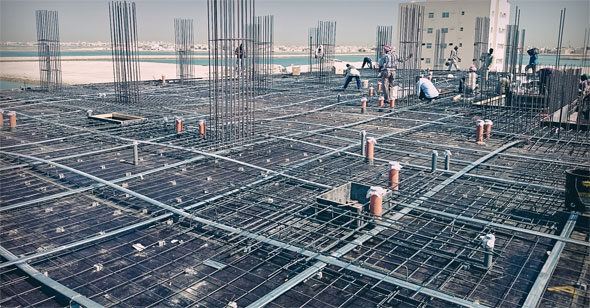Post Tension Slab – Step-by-step Process
- Concrete Cost Estimator
- Concrete Continuous Footing
- Landscape Bidding and Estimating
- Construction Cost Estimating
- Concrete and steel cost estimation
- Construction Cost Estimate Breakdown
- Construction Estimating Worksheet
- Home Construction Cost Estimate
- Estimate Pricing Sheet
- Sheet for General Contractor
- Construction Cost Estimate
- Labor Materials Cost Estimator
- Masonry Estimating Sheet
- Sheet for Building Contractor
- Construction Schedule Bar chart
- General Cost Estimator Sheet
- General Construction Estimate
- Building and Road Estimating Sheet
- Detailed expense estimates
- Door and Window Takeoff Sheet
- General Construction Cost Estimating Sheet

This construction video shows the detailed methods for developing post tension slab. Post-tensioning is just a process of developing pre-stressed concrete, masonry, and other structural elements.
Prior to pour a post-tension slab, steel strands or cables known as tendons with superior strength, are placed in a tight grid. These provide support as well as strength to the slab as soon as it has cured. The tendons are covered in plastic in order that they are not directly connected with the concrete. Once the grid is formed, the concrete is poured. Additional precaution must be taken to ensure that the tendons stay at the exact depth.
Construction of post-tensioned slabs on grade is identical to applying reinforcing steel, exclusive of the tensioning step. Cables are organized with the instructions provided by the engineer and run through the center of the slab. For residential construction, generally tendons at 48 inches are found. Commercial foundations contain much more steel. Tendons are routed around obstructions.
A residential post-tensioned concrete slab is usually 8 inches thick and applies 3000 psi concrete. As soon as the concrete has achieved strength to 2000 psi, usually within the 3 to 10 days suggested by PTI, the tendons are stressed.
Now-a-days Tendons belong to seven high-strength steel wires which are tied together and arranged within a plastic duct. At each end, there is a PT anchor in pockets implanted into the slab edge. If the strands are stressed, the wires are expanded around 4 inches for a 50 foot strand to use 33,000 pounds of load. Stressing should be performed by competent workers. Once the stressing is finished, the tendon is segregated and the pocket in which the anchors are situated is stuffed with grout to safeguard them from erosion.
If a post-tension slab is used in place of normal concrete, cost is saved significantly as there is a low depth of concrete applied to get the similar end result, construction costs are minimized. This is specifically useful for developing skyscrapers and office buildings.

Image Courtesy: hhc-gulf.com
- Application of concrete calculator
- Roofing Calculator can streamline the roof estimating process
- House construction cost calculator
- Engineering column design excel spreadsheet
- Material Estimating Sheet with Excel
- Materials List and Cost Estimate Worksheet
- Concrete Slab Estimating Calculator Sheet
- Common types of foundations for buildings
- Online calculation of construction materials
- Estimating with Excel for the Small Contractor
- Concrete Beam Design Spreadsheet
- Virtual Construction Management app for construction
- Autodesk’s Project Skyscraper
- Reed Construction’s Reed Insight
- Manage your construction project documentation
- Costimator, the popular cost estimating software
- On Center Software for construction professionals
- Free Construction Estimating Software
- Plumbing Calc Pro
- Cost Estimate Worksheet
- HVAC Piping Quantity Takeoff Worksheet
- Construction Estimating Software Sheet
- Estimate Cost Templates
- Construction Punch List
- Construction cost estimating template consisting estimating basic
- Gantt Chart Template for Excel
- Download Civil Engineering Spreadsheets with Verification
- The Building Advisor Estimating and Budgeting Worksheet
- Spreadsheet for design of concrete bridge
- Construction Estimating Software Free








